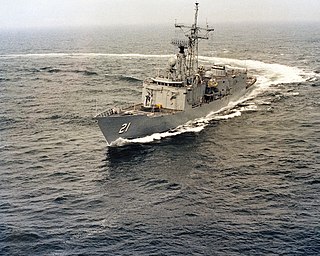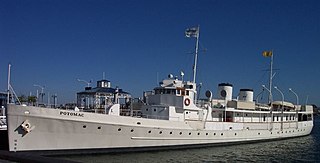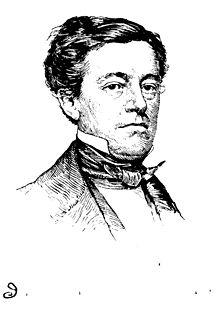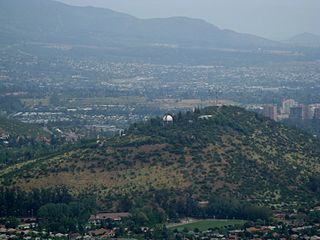This page is based on this
Wikipedia article Text is available under the
CC BY-SA 4.0 license; additional terms may apply.
Images, videos and audio are available under their respective licenses.

USS Flatley (FFG-21) was the thirteenth ship of the Oliver Hazard Perry class of guided-missile frigates. She was the first ship of the U.S. Navy to be named for Vice Admiral James H. Flatley (1906–1958), a leading Naval Aviation tactician from World War II who flew the Grumman F4F Wildcat in the Battle of Coral Sea and subsequently commanded the VF-10 Grim Reapers taking them into combat for the first time.

USS Potomac (AG-25), formerly USCGC Electra, was Franklin Delano Roosevelt's presidential yacht from 1936 until his death in 1945. In January 2016 USS Williamsburg was scrapped leaving USS Potomac and USS Sequoia as the last two still existing presidential yachts. On 3 August 1941, she played a decoy role while Roosevelt held a secret conference to develop the Atlantic Charter. She is now preserved in Oakland, California, as a National Historic Landmark and the only presidential yacht open to the public.

Technical research ships were used by the United States Navy during the 1960s to gather intelligence by monitoring, recording and analyzing wireless electronic communications of nations in various parts of the world. At the time these ships were active, the mission of the ships was covert and discussion of the true mission was prohibited. The mission of the ships was publicly given as conducting research into atmospheric and communications phenomena. However, the true mission was more or less an open secret and the ships were commonly referred to as "spy ships".

James Melville Gilliss was an astronomer, United States naval officer and founder of the United States Naval Observatory.

USS PCE-830 was a U.S.-built Patrol Craft Escort (PCE) vessel launched on 13 June 1943 by the Pullman-Standard Car Company of Chicago, Illinois. She was transferred to the Royal Navy and given the name HMS Kilchrenan in August 1943. She now operates as the cruise ship MS Brahe.

Haskell-class attack transports (APA) were amphibious assault ships of the United States Navy created in 1944. They were designed to transport 1,500 troops and their combat equipment, and land them on hostile shores with the ships' integral landing craft.

The second USS Ardent (AM-340) was a Auk-class minesweeper in the United States Navy.

The YMS-1 class of auxiliary motor minesweepers was established with the laying down of YMS-1 on 4 March 1941. Some were later transferred to the United Kingdom as part of the Second World War Lend-Lease pact between the two nations. One ship, eventually made its way into the Royal Canadian Navy postwar.

An Auxiliary repair dock (ARD) is a type of vessel employed by the U.S. Navy, especially during World War II, when it commissioned 33 ARD vessels: ARD-1 to ARD-33. ARDs were self-sustaining in World War 2. ARD have a rudder to help in tow moving, making ARDs very mobile. ARD have a bow to cut though waves. ARDs have a stern that could be opened or closed. The stern could be closed with bottom-hinged flap gate, that was operated by hydraulic rams. This stern gate could lowered for ship entrance into the submerged dock and then closed to keep out wave. They were built by the Pacific Bridge Company, in Alameda, California.

The Brown Shipbuilding Company was founded in Houston, Texas, in 1942 as a subsidiary of Brown and Root by brothers Herman and George R. Brown to build ships for the U.S. Navy during World War II. Brown Shipbuilding Company ranked 68th among United States corporations in the value of World War II military production contracts.

USS Draco (AK-79) was an Crater-class cargo ship commissioned by the US Navy for service in World War II. Named after the constellation Draco. She was responsible for delivering goods and equipment to locations in the war zone.

The National Astronomical Observatory of Chile is an astronomical observatory owned and operated by the Department of Astronomy of the University of Chile (UCh). It is located on Cerro Calán, a hill in the commune of Las Condes. The commune is an eastern suburb of Santiago located in Santiago Province of the Santiago Metropolitan Region. OAN was founded in 1852 and became a part of UCh in 1927. The facility on Cerro Calán was completed in 1962.

The Type R ship is a United States Maritime Administration (MARAD) designation for World War II refrigerated cargo ship, also called a reefer ship. The R type ship was used in World War II, Korean War, Vietnam War and the Cold War. Type R ships were used to transport perishable commodities which require temperature-controlled transportation, such as fruit, meat, fish, vegetables, dairy products and other foods. The US Maritime Commission ordered 41 new refrigerated ships for the US Navy. Because of the difficulty of building refrigerated ships only two were delivered in 1944, and just 26 were delivered in 1945 and the remainder in 1946–48. The 41 R type ships were built in four groups. Two of design types were modified type C1 ships and two were modified type C2 ships. The United Fruit Company operated many of the R type ships in World War II. The type R2-S-BV1 became the US Navy Alstede-class stores ship and the type R1-M-AV3 became the US Navy Adria-class stores ship.

Auxiliary floating drydock are US Navy floating dry docks that are able to submerge under water and be placed under a ship in need of repair below the water line. Floating drydocks then rise up under the ship raising the ship out of the water. The ship is now blocked on the deck of the floating dry dock for repair. Most floating drydocks had no engine and are towed by tugboats to locations. Floating dry docks come in a different sizes to accommodate varying ship sizes. The large floating drydocks come in sections and can be assembled together to increase the size and lift power. Ballast pontoons tanks are flooded with water to submerge or pumped dry to raise the ship.
















